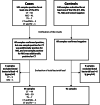Bacterial vaginosis-associated vaginal microbiota is an age-independent risk factor for Chlamydia trachomatis, Mycoplasma genitalium and Trichomonas vaginalis infections in low-risk women, St. Petersburg, Russia
- PMID: 32036466
- PMCID: PMC7303053
- DOI: 10.1007/s10096-020-03831-w
Bacterial vaginosis-associated vaginal microbiota is an age-independent risk factor for Chlamydia trachomatis, Mycoplasma genitalium and Trichomonas vaginalis infections in low-risk women, St. Petersburg, Russia
Abstract
The large majority of studies investigating associations between bacterial vaginosis (BV) and sexually transmitted infections (STIs) have been conducted among predominantly young women with high risk for STIs. Since a risky sexual behavior is a significant risk factor for both STIs and BV, this creates a bias toward an increased association between BV and STIs. This study evaluated associations between BV-associated vaginal microbiota and STIs (Chlamydia trachomatis, Mycoplasma genitalium, Trichomonas vaginalis, and Neisseria gonorrhoeae) in a population of women with low risk for STIs and investigated STI outcomes depending on the dominating Lactobacillus species. Repository cervicovaginal samples collected from reproductive-age women from January 2014 to February 2019 were characterized for vaginal microbiota types and the STIs using multiplex real-time PCR assays. In total, 95 STI-positive and 91 STI-negative samples were included. A significant, age-independent association between BV-associated vaginal microbiota and the presence of C. trachomatis, M. genitalium, and T. vaginalis infections was identified (age-adjusted odds ratios 2.92 [95% confidence interval (CI) 1.24-7.03], 2.88 [95% CI 1.19-7.16], and 9.75 × 107 [95% CI 13.03-∞], respectively). Normal vaginal microbiota dominated by Lactobacillus crispatus, L. gasseri, or L. jensenii was a strong protective factor against C. trachomatis and/or M. genitalium infections, whereas L. iners-dominated microbiota was not significantly associated with C. trachomatis and/or M. genitalium positivity. The results of the present study confirm that STI prevention strategies should include interventions that also reduce the incidence of BV and promote a protective vaginal microbiota in both high- and low-risk women.
Keywords: Bacterial vaginosis; Chlamydia trachomatis; Low-risk women; Mycoplasma genitalium; Sexually transmitted infections; Trichomonas vaginalis.
Conflict of interest statement
The authors declare that they have no conflicts of interest.
Figures
Similar articles
-
Vaginitis and risk of sexually transmitted infections: results of a multi-center U.S. clinical study using STI nucleic acid amplification testing.J Clin Microbiol. 2024 Sep 11;62(9):e0081624. doi: 10.1128/jcm.00816-24. Epub 2024 Aug 14. J Clin Microbiol. 2024. PMID: 39140739 Free PMC article.
-
Molecular Identification of Cervical Microbes in HIV-Negative and HIV-Positive Women in an African Setting Using a Customized Bacterial Vaginosis Microbial DNA Quantitative PCR (qPCR) Array.Microbiol Spectr. 2022 Jun 29;10(3):e0222921. doi: 10.1128/spectrum.02229-21. Epub 2022 Jun 1. Microbiol Spectr. 2022. PMID: 35647888 Free PMC article.
-
Identifying a consensus sample type to test for Chlamydia trachomatis, Neisseria gonorrhoeae, Mycoplasma genitalium, Trichomonas vaginalis and human papillomavirus.Clin Microbiol Infect. 2018 Dec;24(12):1328-1332. doi: 10.1016/j.cmi.2018.03.013. Epub 2018 Mar 17. Clin Microbiol Infect. 2018. PMID: 29559392
-
The two-sided role of the vaginal microbiome in Chlamydia trachomatis and Mycoplasma genitalium pathogenesis.J Reprod Immunol. 2018 Nov;130:11-17. doi: 10.1016/j.jri.2018.08.006. Epub 2018 Aug 22. J Reprod Immunol. 2018. PMID: 30149363 Review.
-
The vaginal microbiota and its association with human papillomavirus, Chlamydia trachomatis, Neisseria gonorrhoeae and Mycoplasma genitalium infections: a systematic review and meta-analysis.Clin Microbiol Infect. 2019 Jan;25(1):35-47. doi: 10.1016/j.cmi.2018.04.019. Epub 2018 May 3. Clin Microbiol Infect. 2019. PMID: 29729331 Free PMC article.
Cited by
-
Treatment patterns and economic burden of bacterial vaginosis among commercially insured women in the USA.J Comp Eff Res. 2024 Jan;13(1):e230079. doi: 10.57264/cer-2023-0079. Epub 2023 Dec 15. J Comp Eff Res. 2024. PMID: 38099520 Free PMC article.
-
Clinical Presentations and Treatment Outcomes of Mycoplasma genitalium Infections at a Large New York City Health Care System.Sex Transm Dis. 2024 Mar 1;51(3):199-205. doi: 10.1097/OLQ.0000000000001911. Epub 2023 Dec 13. Sex Transm Dis. 2024. PMID: 38100794 Free PMC article.
-
Restriction and evasion: a review of IFNγ-mediated cell-autonomous defense pathways during genital Chlamydia infection.Pathog Dis. 2024 Feb 7;82:ftae019. doi: 10.1093/femspd/ftae019. Pathog Dis. 2024. PMID: 39210512 Free PMC article. Review.
-
Vaginitis and risk of sexually transmitted infections: results of a multi-center U.S. clinical study using STI nucleic acid amplification testing.J Clin Microbiol. 2024 Sep 11;62(9):e0081624. doi: 10.1128/jcm.00816-24. Epub 2024 Aug 14. J Clin Microbiol. 2024. PMID: 39140739 Free PMC article.
-
MinION, a portable long-read sequencer, enables rapid vaginal microbiota analysis in a clinical setting.BMC Med Genomics. 2022 Mar 25;15(1):68. doi: 10.1186/s12920-022-01218-8. BMC Med Genomics. 2022. PMID: 35337329 Free PMC article.
References
MeSH terms
Grants and funding
LinkOut - more resources
Full Text Sources
Medical


